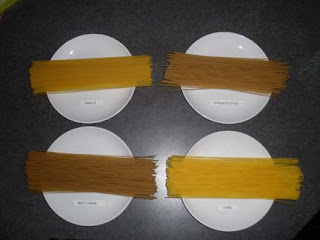Background
During the preparation of a recent dinner, it seemed that Spaghetti Style gluten-free spaghetti cooked differently than Barilla durum wheat spaghetti, viz. equal amounts of the dry product appeared to yield different amounts of cooked pasta. This anomaly was in direct contravention to the manufacturers' claim that, in both cases, two ounces (dry weight) constituted a single serving of pasta. Given the serious consequences for consumers' satisfaction and fullness index, it was deemed necessary to perform further testing at the first available opportunity.
Test plan and execution
Four different brands of spaghetti were acquired from the supermarket, as follows: Barilla traditional semolina and durum wheat spaghetti (the control); Pasta Joy Spaghetti Style with Rice Bran (Brown Rice Pasta) (see previous post); De Boles Multi Grain Spaghetti Style pasta (a mixture of brown and white rice flours, amaranth flour, quinoa flour, and xanthan gum); and De Boles Corn Spaghetti Style pasta (100% yellow corn flour). Except for the Barilla, all the noodles were certified gluten-free.
Equal amounts of dried pasta were carefully measured (dry weight = 113.4 grams or 4 oz.) and labelled as follows:
A simple displacement setup was engineered and the respective volumes of pasta (dry weight) established:
Each variety was then cooked according to the manufacturer's instructions. At the end of cooking, the weight and volume were measured again. Note was also taken of overall appeal.
Results
Equal dry weights of pasta yielded different uncooked displacement volumes, detailed below. In all cases, both volume and weight increased during cooking, although there was considerable variation from brand to brand:
Barilla. Initial weight: 113.4g. Cooked weight: 283.5g. Initial disp. volume: 120ml. Cooked disp. volume: 300ml. Increase in weight: 150%. Increase in volume: 150%.
Spaghetti Style. Initial weight: 113.4g. Cooked weight: 205.5g. Initial disp. volume: 100ml. Cooked disp. volume: 200 ml. Increase in weight: 81%. Increase in volume: 100%.
Multi-Grain. Initial weight: 113.4g. Cooked weight: 198.4g. Initial disp. volume: 88ml. Cooked disp. volume: 200ml. Increase in weight: 75%. Increase in volume: 127%.
Corn. Initial weight: 113.4g. Cooked weight: 212.6g. Initial disp. volume: 98ml. Cooked disp. volume: 225ml. Increase in weight: 88%. Increase in volume: 130%.
Discussion
Initial suspicions that g/f pasta cooks differently from traditional varieties were confirmed. All the pasta increased in both weight and volume during cooking, rendering groundless the earlier fear that some of the Spaghetti Style had somehow disappeared out the ventilation fan (this observational error may be explained by the fact that of all the noodles, the Spaghetti Style's volume increased the least). The Barilla's increase in weight and volume (a whopping 150% in both cases) was unmatched by any of the g/f products, with the corn pasta trailing in second place with an 88% increase in weight. To match the final desirable Barilla weight (cooked weight being deemed more important than volume when evaluating the fullness index) would require 156g of Spaghetti Style; 162g of multi-grain; and 151g of corn.
Of the three g/f varieties, the corn pasta was a clear winner in texture and taste - although it more resembled capelli d'angelo than spaghetti. This detail was of little consequence, however, since the Kid Squid reported he would happily eat a bowlful with his favorite sauce (a rash statement that will be tested for veracity later this week: reportage to follow). The Spaghetti Style has been described elsewhere. Of the mult-grain pasta, the less said the better: it tasted as unpleasant as the picture above suggests (the multigrain is the slimy pile on the lower left) and will not be gracing my pantry shelves any time soon.
Next up: We discover we're sick of pasta and decide to have chicken curry and basmati rice for dinner.



No comments:
Post a Comment